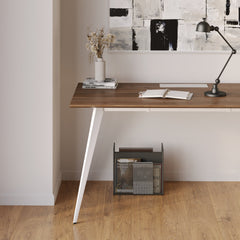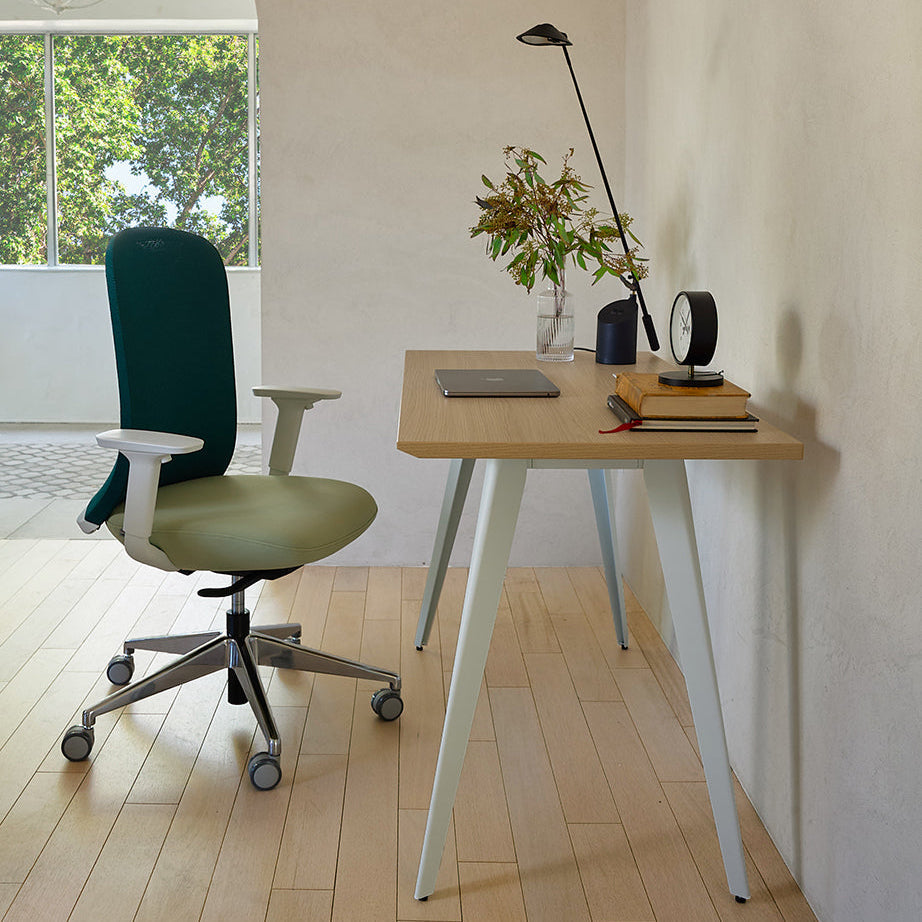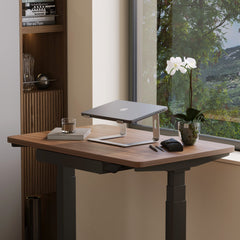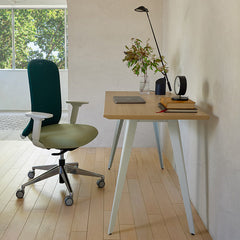Get 10% off your first order
Find the office furniture that’s designed to match your style, comfort, and needs perfectly. Subscribe
Boundary Work From Home Setup: How to Define Your Home Office Zone

Visit quiz page to see how we makes it easy to create an inspiring workplace


Your workspace should feel like a place that helps you breathe easier, not a source of stress. A soft, well-designed space calms your senses, improves focus, and supports long-term productivity. Instead of relying on hard lines or harsh colors, consider textures, tones, and lighting that create quiet harmony.
This guide explores design choices that blend comfort and clarity—perfect for anyone seeking a more peaceful workday without losing efficiency.
Soft design is not about excess decoration—it’s about intention. It focuses on light, texture, and flow to transform a rigid workspace into one that feels nurturing.
Rounded furniture edges
Muted, natural colors
Plush or matte textures
Soft, diffused lighting
Your space should feel calm to look at and even calmer to sit in.
The desk is where your energy begins. The Small Standing Desk Maryland perfectly combines movement and minimalism, allowing your body and mind to stay in sync throughout the day.
|
Feature |
Benefit |
Why It Matters |
|
Adjustable height |
Promotes movement |
Reduces stiffness |
|
Neutral finish |
Visually soothing |
Complements décor |
|
Compact form |
Maintains openness |
Avoids visual overload |
|
Rounded corners |
Adds safety and softness |
Enhances comfort |
A workspace feels more peaceful when furniture design supports natural rhythm.
The right light can make your office feel like a gentle morning. Avoid harsh brightness—aim for glow, not glare.
Use warm bulbs between 2700–3000K.
Position your desk near natural light.
Add small lamps for evening tasks.
Choose fixtures with diffusers for balanced brightness.
Light is the most powerful design element—it dictates how your space feels and how your mind responds.
Rigid furniture creates tension, while adaptive design promotes flow. A flexible standing desk helps you switch between focus and movement naturally.
Choose lightweight, movable pieces.
Avoid oversized furniture that blocks sightlines.
Keep spacing consistent between furniture elements.
Opt for rounded shapes instead of sharp corners.
Fluid furniture supports both posture and peace.
Texture plays a key role in how comfort is perceived. Even visually, soft materials relax the eyes.
|
Material |
Feel |
Best Use |
|
Linen |
Airy and breathable |
Curtains or seat covers |
|
Felt |
Warm and subtle |
Pinboards or mats |
|
Matte wood |
Natural softness |
Table surfaces |
|
Cotton blends |
Gentle comfort |
Chair padding |
Soft textures slow the pace of your space and your thoughts.
Clutter creates noise—even without sound. Choose an office desk with hidden compartments to maintain flow and order.
Keep cords out of sight.
Store items vertically to save space.
Limit decorations to meaningful pieces.
Use consistent, neutral containers.
Clean spaces quiet the mind and sharpen your focus.

Soft colors are powerful mood tools. Warm neutrals and cool blues or greens foster calm without feeling sterile.
|
Color |
Emotion |
Ideal Use |
|
Beige |
Warmth |
Wall tones |
|
Dusty blue |
Focus |
Accessories |
|
Sage green |
Renewal |
Chair fabrics |
|
Light wood |
Balance |
Desk and accents |
Choosing calm hues helps anchor both mood and energy.
A soft workspace must also be supportive. Pair design comfort with posture health using an ergonomic setup.
The right ergonomic arm accessory can relieve tension while blending naturally into your workspace aesthetic.
Keep your elbows at a 90° angle.
Position screens at eye level.
Use chairs with lumbar support.
Allow room for easy movement.
Ergonomics shouldn’t interrupt design—it should enhance it.
Plants and organic materials make a workspace feel grounded. A few thoughtful touches can turn sterile into serene.
Add small potted plants for color and oxygen.
Choose wood surfaces for warmth.
Keep windows uncovered for natural light.
Mix natural fibers with neutral textiles.
Nature quietly restores attention and reduces fatigue.
According to remote work insights, comfort and design flexibility boost motivation and focus. Creating a soft, welcoming workspace ensures your surroundings encourage—not exhaust—your creativity.
Keep a rhythm of light and calm.
Blend natural materials for warmth.
Make comfort an intentional design choice.
Reflect your personal pace and workflow.
Relaxed design supports deep work without draining energy.
Your space reflects your inner state. A relaxed atmosphere doesn’t happen by accident—it’s the result of balance between physical comfort and mental clarity.
A calm layout fosters confidence.
Soft materials evoke care and comfort.
Open spaces invite focus.
Harmony builds daily resilience.
When your environment supports you, motivation follows naturally.
A relaxed atmosphere isn’t only about furniture—it’s about the subtle touches that make a workspace feel welcoming. Fabrics, curtains, rugs, and seat cushions add gentle warmth to balance the sleekness of modern pieces.
|
Element |
Material |
Impact |
|
Curtains |
Linen or sheer cotton |
Filters light softly |
|
Rug |
Wool or jute |
Adds tactile warmth |
|
Chair cushion |
Memory foam with neutral cover |
Provides comfort and texture |
|
Throw blanket |
Knit or fleece |
Introduces coziness and calm |
Layering textures helps tone down sharp angles, creating visual ease and comfort you can feel.
An organized space allows your mind to stay light. A standing desk setup supports this flow by giving you the flexibility to shift positions, stretch, and reset throughout the day.
Keep essential items within arm’s reach.
Designate a soft corner for breaks.
Position your screen to reduce glare.
Maintain balance between open space and purpose zones.
Your space should move with you, not hold you still. Designing for rhythm keeps your energy steady all day.

Personal details give character to your workspace—but too many can feel distracting. Use thoughtful accents that express personality without overpowering the calm you’ve built.
Frame one meaningful photo or artwork.
Use a neutral vase with dried flowers for a natural touch.
Display a small office desk organizer to blend function and form.
Limit decorative items to three per surface.
The right balance between personality and simplicity turns your workspace into a reflection of quiet confidence.
Soft design choices transform your office into more than a workspace—it becomes an environment that listens. Every texture, color, and line contributes to how your mind settles and your energy sustains.
Choose calm over clutter.
Prioritize softness without losing structure.
Design for function and feeling equally.
Let comfort guide your work rhythm.
A relaxed workspace isn’t about perfection—it’s about ease, warmth, and presence.

Boundary Work From Home Setup: How to Define Your Home Office Zone

Hidden Hazards: 5 Ergonomic Traps Derailing Your Remote Work

Decoding Deep Work: The Neuroscience of Your Desktop
Get 10% off your first order
Find the office furniture that’s designed to match your style, comfort, and needs perfectly. Subscribe
Leave a comment